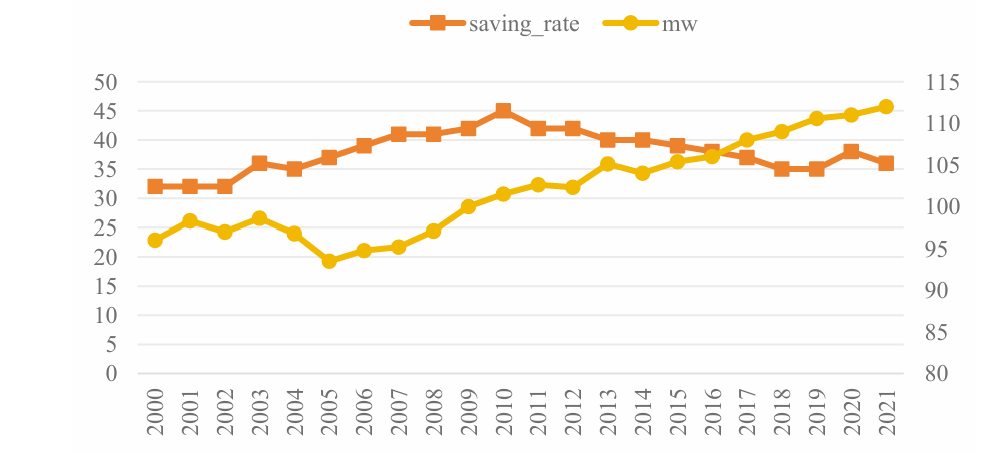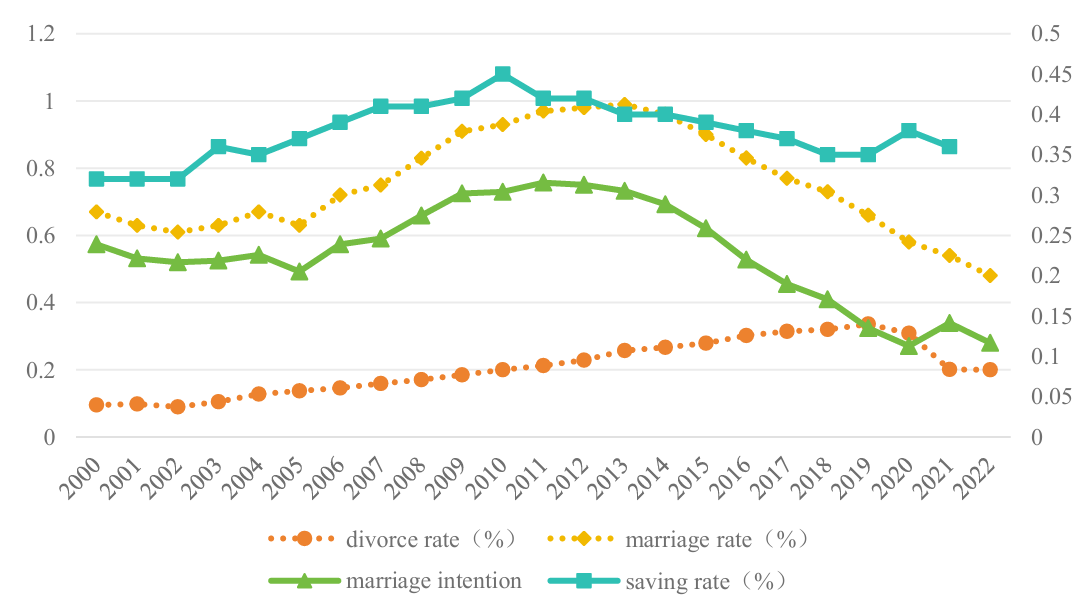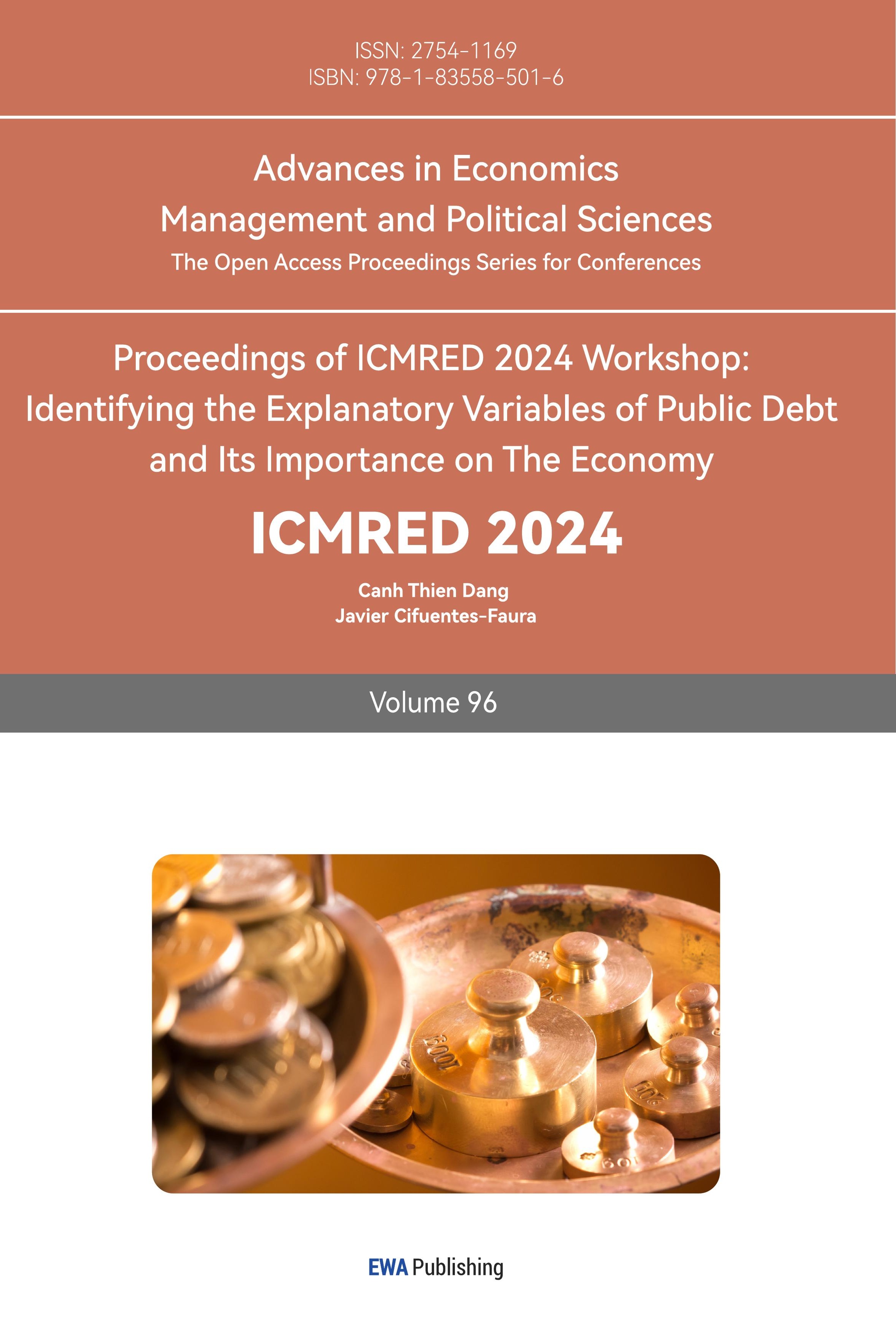1.Introduction
According to the China Statistical Yearbook 2023, the number of first marriages in China in 2022 is down 9.16 percent from 2021, and the first time in many years that the number of first marriages is lower than 11 million [1]. The decline in the marriage rate has become an important issue facing Chinese society in recent years.
A low marriage rate leads to a low fertility rate, which makes China face problems of an aging population and labor shortage, which may hurt economic development. With the decrease in willingness to marry, the number of people who buy houses and those of marriageable age will decline, and these unmarried people tend to have a higher level of savings than married people [2].
People generally have negative comments on the high savings rate of Chinese residents, believing that it leads to the lack of consumption power in China and induces a large amount of idle production capacity, thus slowing down China's economic growth. However, after more thorough research and observation in recent years, it has been realized that a high savings rate also plays a great positive role in China's social stability and economic growth. On the one hand, it relieves people's anxiety and maintains social security and stability [3]. On the other hand, it is the premise of promoting China's capital accumulation and provides a large source of funds for China's economic growth.
According to the relevant references obtained from CNKI, the China Statistical Yearbook of the Office for National Statistics, and the relevant data from 2000 to 2021, the inflection point of the decline of China's household savings rate since 2010 is similar to the changing trend of willingness to marry. It is enlightening to understand the reasons for the change of household savings rate from the perspective of marriage.
By studying the correlation and influencing factors between the two, this paper further expands and enriches the literature on the impact of population on savings rate, providing a new perspective on the changing trend of household savings rate.
2.Theory Analysis
Wei proposed the concept of "competitive saving" based on China's national conditions and traditional marriage habits as well as the fact that the gender ratio in China is unbalanced. In other words, under the background of the gender ratio imbalance, parents (especially parents of boys) will compete to increase savings to improve the attractiveness of their children in the marriage market [4]. Therefore, with the increase in the gender ratio, the savings rate of the household sector will be higher, and the family will be more inclined to save to improve the competitiveness of their sons in the marriage market. This leads to competitive saving at the level of the whole society, which pushes up the household saving rate. Therefore, in their view, competitive saving caused by China's gender imbalance is an important reason for China's high savings rate.
However, Wei's research time was before 2011, and the data used were old, and the inflection point of household savings rate decline in 2010 did not appear. Figure 1 is drawn from the data of household savings rate (saving_rate) and marriageable male/female sex ratio (mw) obtained from the China Statistical Yearbook [1]. It can be found that although the ratio of marriageable men to women (mw) is still in the rising range after 2010, the household saving rate (mw) shows a downward trend. Therefore, whether there are other factors affecting the decline of household saving rate should be considered.

Figure 1: Saving rate and sex ratio (Photo/Picture credit: Original).
Since the number of marriage registrations is affected by the number of marriageable population and other backgrounds, Ye believes that the marriage rate can more scientifically and objectively reflect the willingness to marry and the situation of the society [5]. Therefore, this paper adopts the difference between the marriage rate and the divorce rate to reflect the willingness to marry society. Figure 2 is used to observe the marriage rate curve, divorce rate curve, and the difference between them (marriage intention curve) and household saving rate (saving_rate)[1]. Looking at the marriage rate, China's marriage rate rose from 0.67% in 2000 to 0.99% in 2013 and has declined year by year in recent years to only 0.48% in 2022. Secondly, the indicator of willingness to marry has also shown an obvious downward trend in recent years, which is similar to the changing trend of household savings rate. Therefore, it is preliminarily believed that the decline in willingness to marry in recent years is an important reason for the decline in household savings rate.

Figure 2: Willingness to marry and saving rate.
3.Research Methods and Processes
3.1.Empirical Studies
Based on previous studies, this paper analyzes the correlation between the savings rate and willingness to marry of Chinese residents from 2000 to 2021 and uses stata software to establish a multiple regression model and ridge regression model to study the correlation between the two. To improve the credibility of the study, the relevant literature should be used to determine which factors will affect the research results and study them as control variables in the empirical process.
There are many factors affecting the household saving rate. Therefore, this paper selects the control variables based on references, takes China's willingness to marry and household saving rate as the analysis variables, and unifies the unit of measurement as a percentage (%). At the economic level, the growth rate of disposable income (dpi), the annual growth rate of the Consumer Price Index (cpi), the one-year deposit interest rate (r), and the annual growth rate of the average price of residential commercial housing (hp) are selected as the control variables that affect the household savings rate [6]. In terms of population structure, male to female ratio (mw) between 20 and 30 years of marriageable age, China's old-age dependency ratio (dro), and China's child dependency ratio (drc) are selected as control variables [7]. Table 1 shows the descriptive statistics of the data in this paper.
Table 1: Descriptive Statistics.
|
(1) |
(2) |
(3) |
(4) |
(5) |
|
|
VARIABLES |
N |
mean |
sd |
min |
max |
|
savings rate |
22 |
37.91 |
3.584 |
32 |
45 |
|
willingness to marry |
22 |
0.561 |
0.142 |
0.271 |
0.757 |
|
cpi |
22 |
2.182 |
1.732 |
0.800 |
5.900 |
|
dpi |
22 |
11.16 |
3.300 |
4.740 |
18.74 |
|
r |
22 |
2.339 |
0.773 |
1.500 |
4.140 |
|
hp |
22 |
8.297 |
5.992 |
1.890 |
24.70 |
|
mw |
22 |
102.0 |
5.746 |
93.50 |
112 |
|
dro |
22 |
13.25 |
3.172 |
9.900 |
20.80 |
|
drc |
22 |
25.96 |
3.635 |
22.10 |
32.60 |
A multivariate regression model was set up with the above data and the results showed that willingness to marry was significant at the 5% significance level with a coefficient of 23.980. Meanwhile, R2=0.842 showed that the independent variable could explain 84.2% of the variance in the dependent variable, and the regression equation had a good fit. However the correlation coefficient of willingness to marry was found to be large, so the multivariate linear regression equation was checked for multicollinearity. The results are shown in Table 2. It is found that there are many values with VIF>10 and multicollinearity among the independent variables.
Table 2: Variance Inflation Factor.
|
VARIABLES |
VIF |
|
willingness to marry |
16.76 |
|
cpi |
4.25 |
|
dpi |
4.97 |
|
r |
9.79 |
|
hp |
1.31 |
|
mw |
20.11 |
|
dro |
28.93 |
|
drc |
8.12 |
Therefore, ridge regression analysis on this set of data can eliminate some effects of multicollinearity. In linear regression analysis, the collinearity of independent variables is resolved using the research procedure known as ridge regression. Ridge regression provides an estimable regression coefficient by introducing K identity matrices. The minimal K value at which each independent variable's standardized regression coefficient tends to be stable is the K value selection principle. The smaller the K value is, the smaller the deviation is. When the K value is 0, it is ordinary linear OLS regression. Table 3 below outputs VIF values with different K values. In general, when the maximum value of VIF is less than 10, the corresponding minimum K value is the best K value. After determining the value of K is 0.02, the ridge regression model estimate is obtained by input it
into the model.
Table 3: K and VIF.
|
K |
VIF |
willingness to marry |
cpi |
dpi |
r |
hp |
mw |
dro |
drc |
|
0 |
28.934 |
16.763 |
4.253 |
4.972 |
9.794 |
1.31 |
20.11 |
28.93 |
8.119 |
|
0.01 |
11.993 |
7.758 |
3.098 |
4.161 |
6.208 |
1.21 |
10.39 |
11.99 |
5.306 |
|
0.02 |
6.854 |
4.827 |
2.6 |
3.594 |
4.754 |
1.149 |
6.816 |
6.854 |
3.999 |
|
0.03 |
4.966 |
3.451 |
2.288 |
3.165 |
3.909 |
1.1 |
4.966 |
4.593 |
3.209 |
Make willingness to marry, cpi, dpi, r, hp, mw, dro, drc as independent variables, and save_rate as the dependent variable, performing the ridge regression with K=2. Results in Table 4 show that the model R2=0.825 means that the independent variables can explain 82.5% of the variation of saving_rate, which is not much different from the original multiple regression model.
In the next step, a ridge regression ANOVA test is carried out to determine whether the model is meaningful. The P-value of this model is 0.001(less than 0.05), so the ridge regression is significant.
Set saving_rate=y, willingness to marry=x, cpi=c1, dpi=c2, r=c3, hp=c4, mw=c5, dro=c6, drc=c7.The ridge regression equation (1) can be obtained by observing the coefficient B in Table4 below:
\( y=64.715+13.625∙x+0.266∙{c_{1}}+0.132∙{c_{2}}+0.028∙{c_{3}}+0.055∙{c_{4}}-0.328∙{c_{5}}+0.707∙{c_{6}}-0.494{c_{7}} \)(1)
Table 4: Ridge Regression Results.
|
Ridge Regression Results |
||||||
|
Unstandardized Coefficients |
Standardized Coefficients |
T |
P |
VIF |
||
|
B |
Standard Error |
Beta |
||||
|
cons |
64.715 |
23.46 |
- |
2.758 |
0.016* |
- |
|
x |
13.526 |
6.428 |
0.537 |
2.104 |
0.055 |
4.827 |
|
c1 |
0.226 |
0.387 |
0.109 |
0.583 |
0.57 |
2.6 |
|
c2 |
0.132 |
0.239 |
0.121 |
0.551 |
0.591 |
3.594 |
|
c3 |
0.028 |
1.173 |
0.006 |
0.024 |
0.981 |
4.754 |
|
c4 |
0.055 |
0.074 |
0.091 |
0.735 |
0.476 |
1.149 |
|
c5 |
-0.328 |
0.189 |
0.525 |
1.733 |
0.107 |
6.816 |
|
c6 |
0.707 |
0.343 |
0.626 |
2.059 |
0.06 |
6.854 |
|
c7 |
-0.494 |
0.229 |
0.501 |
2.156 |
0.05 |
3.999 |
|
R2 |
0.825 |
|||||
|
R2 |
0.717 |
|||||
|
F |
F (8, 13) = 7.648, p = 0.001 |
|||||
|
* p<0.05 ** p<0.01 |
||||||
It was found that a 1 unit willingness to marry change produced 13.625 units of saving_rate change. willingness to marry has a big impact on the savings rate. But the willingness to marry P-value of 0.055 is slightly greater than the 95% significant P-value of 0.05. Empirical results may be slightly off the mark.
3.2.Error Analysis
There are many factors affecting the household savings rate, which cannot all be taken into account. When constructing a model to verify the effect of willingness to marry change on household savings from a macro perspective, only the data at the national level can be used to verify the hypothesis. Due to the large differences in population among different provinces, the impact of regional factors on household savings rates can not be well reflected. If all or part of provincial data can be used for panel data analysis, the impact of regional factors on household savings rate can be more clearly distinguished, making the conclusion more convincing [8].
4.Conclusion
Through this study, it can be found that the change in Chinese household savings rate during 2000-2021 is significantly influenced by social willingness to marry, and the two are positively correlated. After excluding the influence of multicollinearity among independent variables, the ridge regression model is established. The empirical results show that a 1% decrease or increase in willingness to marry will lead to a 13.526% decrease or increase in household savings rate. The decrease in willingness to marry among marriageable people is an important reason for the decrease in household savings rate in recent years.
With the fast pace of life, high work pressure, and increasing demand in modern society, many young people of marriageable age choose to live alone and are reluctant to get married. They prefer to enjoy the flexibility and freedom of a single life. Think that marriage will limit freedom and be detrimental to development and career, and do not want to shoulder the responsibilities and pressures of family. All of these reasons have contributed to a decline in the willingness to get married in China in recent years.
The high savings rate is one of the important factors driving China's high economic growth. High savings make bank credit abundant and reduce investment and financing costs for enterprises and the government. Governments and banks have plenty of money to invest in innovation and stimulate economic growth, and these advantages will gradually disappear when the savings rate falls.
Based on this paper, the government can encourage the public to marry through education, publicity, policy formulation, and other means, which can increase the savings rate of Chinese residents to a certain extent, and play a positive role in promoting China's economic growth, capital accumulation, innovation and development, and facing the turbulent world situation. At the same time, it can also improve China's aging population structure and increase labor resources to a certain extent.
References
[1]. Office for National Statistics www.stats.gov.cn/sj/ndsj2024/3/28
[2]. Litian, Y., Hongquan, L. (2017). Saving for marriage? -- empirical evidence from china household tracking survey (CFPS), Financial Research, 6.
[3]. Yong, S. (2024). Moderately reducing high savings rate to boost economic development. securities times, A07.
[4]. Wei, S. J., Zhang, X. (2011) The competitive saving motive: evidence from rising sex ratios and savings rates in China.Journal of Political Economy.
[5]. Yuchen, F. (2022). Improving willingness to marry is a social system Project. China Women's News, 002.
[6]. Yang, P. (2022). Analysis on the influencing factors of high savings rate of Chinese residents. Northern Economic and Trade, (11): 34-37.
[7]. Niu, Z. H. (2022). Study on the impact of population structure on Household Savings Rate: An empirical analysis based on Cobb-Douglas production function. China Price, (01): 59-62.
[8]. Hongya, L., Yuwei, W. (2023). Marital intention, competitive savings and household savings rate. Journal of Guangxi University (Philosophy and Social Sciences Edition), 45(06): 149-160.
Cite this article
Li,J. (2024). The Correlation Between the Willingness to Marry and the Household Savings Rate in China. Advances in Economics, Management and Political Sciences,96,154-159.
Data availability
The datasets used and/or analyzed during the current study will be available from the authors upon reasonable request.
Disclaimer/Publisher's Note
The statements, opinions and data contained in all publications are solely those of the individual author(s) and contributor(s) and not of EWA Publishing and/or the editor(s). EWA Publishing and/or the editor(s) disclaim responsibility for any injury to people or property resulting from any ideas, methods, instructions or products referred to in the content.
About volume
Volume title: Proceedings of ICMRED 2024 Workshop: Identifying the Explanatory Variables of Public Debt and Its Importance on The Economy
© 2024 by the author(s). Licensee EWA Publishing, Oxford, UK. This article is an open access article distributed under the terms and
conditions of the Creative Commons Attribution (CC BY) license. Authors who
publish this series agree to the following terms:
1. Authors retain copyright and grant the series right of first publication with the work simultaneously licensed under a Creative Commons
Attribution License that allows others to share the work with an acknowledgment of the work's authorship and initial publication in this
series.
2. Authors are able to enter into separate, additional contractual arrangements for the non-exclusive distribution of the series's published
version of the work (e.g., post it to an institutional repository or publish it in a book), with an acknowledgment of its initial
publication in this series.
3. Authors are permitted and encouraged to post their work online (e.g., in institutional repositories or on their website) prior to and
during the submission process, as it can lead to productive exchanges, as well as earlier and greater citation of published work (See
Open access policy for details).
References
[1]. Office for National Statistics www.stats.gov.cn/sj/ndsj2024/3/28
[2]. Litian, Y., Hongquan, L. (2017). Saving for marriage? -- empirical evidence from china household tracking survey (CFPS), Financial Research, 6.
[3]. Yong, S. (2024). Moderately reducing high savings rate to boost economic development. securities times, A07.
[4]. Wei, S. J., Zhang, X. (2011) The competitive saving motive: evidence from rising sex ratios and savings rates in China.Journal of Political Economy.
[5]. Yuchen, F. (2022). Improving willingness to marry is a social system Project. China Women's News, 002.
[6]. Yang, P. (2022). Analysis on the influencing factors of high savings rate of Chinese residents. Northern Economic and Trade, (11): 34-37.
[7]. Niu, Z. H. (2022). Study on the impact of population structure on Household Savings Rate: An empirical analysis based on Cobb-Douglas production function. China Price, (01): 59-62.
[8]. Hongya, L., Yuwei, W. (2023). Marital intention, competitive savings and household savings rate. Journal of Guangxi University (Philosophy and Social Sciences Edition), 45(06): 149-160.









